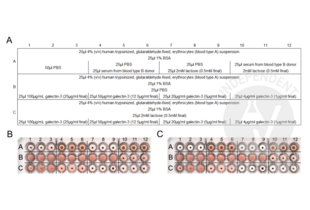Galectin 3 Protein (LGALS3)
-
- Target See all Galectin 3 (LGALS3) Proteins
- Galectin 3 (LGALS3)
- Protein Type
- Recombinant
- Biological Activity
- Active
-
Origin
- Human
-
Source
- Escherichia coli (E. coli)
- Application
- Functional Studies (Func)
- Characteristics
- Recombinant Human Galectin-3 (LGALS3)
- Purity
- >95 % as determined by SDS-PAGE
- Endotoxin Level
- < 1.0 EU of endotoxin/μg of protein
-
-
- Application Notes
- Optimal working dilution should be determined by the investigator.
- Restrictions
- For Research Use only
-
- by
- Sanja Dabelic, Ph.D., Associate Professor, Department of Biochemistry and Molecular Biology, Faculty of Pharmacy and Biochemistry, University of Zagreb
- No.
- #103788
- Date
- 06/17/2019
- Antigen
- LGALS3
- Lot Number
- 158844928901
- Method validated
- Haemagglutination
- Positive Control
human erythrocytes (blood group A)
serum from uncompatible donor (blood group B)
- Negative Control
PBS
0.5mM lactose
- Notes
Passed. The recombinant human galectin-3 ABIN5509728 possesses lectin activity.
- Primary Antibody
- Secondary Antibody
- Full Protocol
- Isolate human erythrocytes and prepare trypsinized,glutaraldehyde-fixed erythrocytes
- Take blood by venipuncture from healthy volunteer (blood type A) in one lavender vacutainer tube (containing EDTA as anticoagulant) and centrifuged at 500×g for 5min at 4°C.
- Remove plasma and white cell ghost layer at the top of the pellet.
- Resuspend red blood cells in 10ml cold PBS by gently aspirating and expelling them with a pipette. Centrifuge red blood cells at 500×g for 5min at 4°C. Remove the supernatant and repeat 3x.
- Resuspend the pellet in 20ml PBS (Gibco) containing 0.05% trypsin and incubate at 37°C for 1h with an occasional shake.
- Centrifuge at 500xg for 5min at 4°C.
- Remove supernatant and resuspend erythrocytes in 10ml cold PBS.
- Wash pellet 3x as described above.
- Resuspend erythrocytes in 25ml PBS containing 1% glutaraldehyde and incubate for 1h at RT with continuous gentle shaking.
- Centrifuge at 500xg for 5min at 4°C.
- Remove supernatant and wash erythrocytes 2x with 0.1M glycine in PBS.
- Wash erythrocytes with PBS.
- Store erythrocytes as 4% (v/v) erythrocyte suspension at 4 °C until use (within one month of preparation).
- Isolation of human serum (blood type B)
- Take blood by venipuncture from healthy volunteer (blood type B) in one red topped vacutainer tube (additive-free vacutainer).
- Allow the blood to clot by leaving it undisturbed at room temperature for 30min.
- Centrifuge at 1000xg for 10min at 4°C.
- Remove serum supernatant and store at -20°C until use.
- Preparation of galectin-3 and lactose
- Reconstitute lyophilized galectin-3 (antibodies-online, ABIN5509728, lot 0158844928901) in sterile, 0.2μm filtered solution of 0.2% bovine serum albumin (BSA) in PBS, according to the manufacturers’ recommendations, to 100μg/ml.
- Dilute D-lactose in PBS to 2mM.
- Measurement of Hemagglutination
- Prepare samples in triplicates as indicated in Figure A in a total volume of 100µl in a microtiter V plate.
- Incubate plate for 1h and 24h at 4°C.
- Determine results by visual examination. Image acquisition on an Amersham Imager 600, Image capturing method colorimetric-transillumination.
- Experimental Notes
Galectin-3 is approximately 30kDa and, like all galectins, contains a carbohydrate-recognition-binding domain (CRD) of about 130 amino acids that enable the specific binding of β-galactosides. For several decades, hemagglutination assay has been used to obtain semi-quantitative data on the sugar binding and specificity of a particular lectin. Active lectins agglutinate erythrocytes by recognizing carbohydrates on the cell surface and forming a cross-linked network in suspension.
By serially diluting the lectin in a 96-well microtiter plate and adding a constant quantity of erythrocytes, the lectin activity can be estimated. Galectin-3 lectin activity is abolished by the addition of lactose, which binds to its CRD domain and consequently inhibits hemagglutination. The assay is usually performed on trypsinized, glutaraldehyde-fixed red blood cells because they are more sensitive to hemagglutination reactions. Addition of bovine serum albumin (BSA) to all wells prevents non-specific interactions and consequently non-specific auto-hemagglutination. As positive control, serum of a non-compatible blood type can be used. Negative control is PBS. Control for abolishing galectin-3 activity is lactose.
The hemagglutination assay is carried out by incubating human erythrocytes (blood group A or B) in the presence of increasing concentrations of galectin-3 in a microtiter V plate for 1h and 24h at RT in a final volume of 100µl. Galectin-3 recognizes glycans on both type A and type B red blood cells at submicromolar concentrations, according to the literature data, but does not bind to blood group O(H) at these concentrations. Commercially available 4% solutions of trypsinized, glutaraldehyde-fixed erythrocytes from various species and (e.g. rabbit) can also been used.
Pre-incubation of galectin-3 for 30min in the presence of 500µM lactose should cause prevention (inhibition) of hemagglutination.
Hemagglutination was detected in wells that contained the positive control without (wells A4-A6) and with lactose (wells A10-12), and in wells with galectin-3 at final concentrations 25μg/mL, 12.5μg/mL, and 5μg/mL (wells B1-9). A galectin-3 concentration of 1μg/ml was insufficient to cause complete hemagglutination (wells B10 to B12). Partial inhibition was detected in wells containing galectin-3 at 25µg/ml in the presence of 0.5mM lactose (well C1-3). At galectin-3 concentrations 12.5µg/ml, 5µg/ml, and 1µg/ml hemagglutination is completely abolished in the presence of 0.5mM lactose (well C4-12).
References:
https://www.ncbi.nlm.nih.gov/pubmed/1259723
https://www.ncbi.nlm.nih.gov/pubmed/10722666
https://www.ncbi.nlm.nih.gov/pubmed/22497898
https://www.ncbi.nlm.nih.gov/pubmed/27328612
https://www.ncbi.nlm.nih.gov/pubmed/30797745
https://www.ncbi.nlm.nih.gov/pubmed/18216021
Validation #103788 (Haemagglutination)![Successfully validated 'Independent Validation' Badge]()
![Successfully validated 'Independent Validation' Badge]() Validation ImagesFull Methods
Validation ImagesFull Methods -
- Format
- Lyophilized
- Reconstitution
- A quick spin of the vial followed by reconstitution in sterile distilled water to a concentration not less than 0.1 mg/mL is recommended. Please note, filter sterilization is a must following reconstitution. This solution can then be diluted into other buffers.
- Storage
- 4 °C,-20 °C
- Storage Comment
- The lyophilized protein is stable for at least one year from date of receipt at -70°C. Upon reconstitution, this cytokine can be stored in working aliquots at 2° - 8°C for one month, or at -20°C for six months, with a carrier protein without detectable loss of activity. Avoid repeated freeze/thaw cycles.
-
- Target
- Galectin 3 (LGALS3)
- Alternative Name
- Galectin-3 (LGALS3) (LGALS3 Products)
- Target Type
- Chemical
- Molecular Weight
- 26,1
- Gene ID
- 3958
- UniProt
- P17931
- Pathways
- RTK Signaling
-


 (1 validation)
(1 validation)



